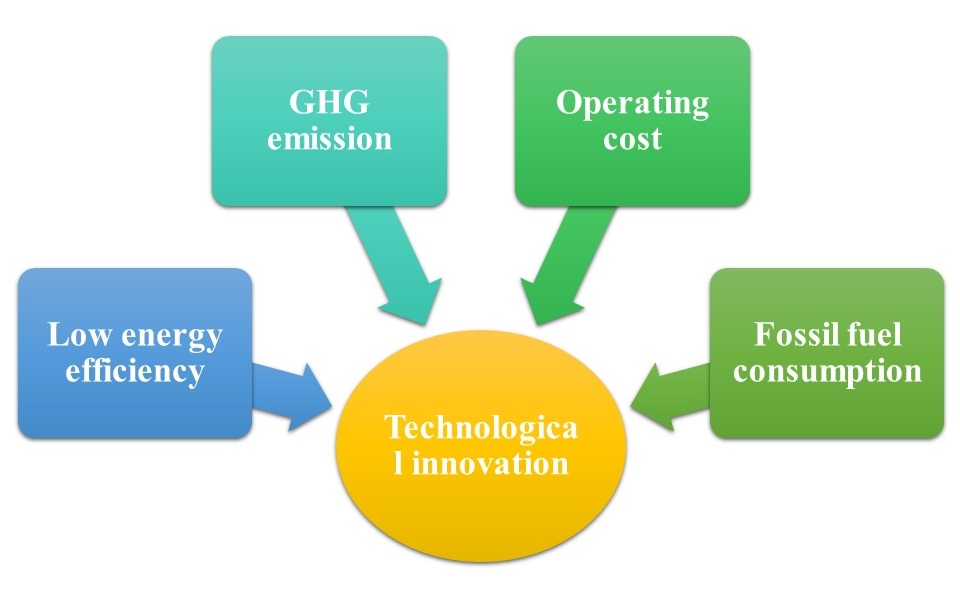| Convective + infrared |
Turnip |
Variables: drying temperature (50, 60, and 70 °C) and thickness (2, 4, and 6 mm). Pretreatments: bleaching (at 90 °C for 2 min), ultrasonic (at 30 °C for 10 min), and microwave (360 W per 2.5 minutes). There are in the dryer two Infrared (IR) lamps (500 W each) |
70 °C and 2 mm proved to be the optimal condition in drying parameters such as time (20 min, specific energy consumption (21.57 MJ/kg), energy efficiency (15.23%), and dryer efficiency (21.2%). The use of different pretreatments exerts different influences on the samples. |
Taghinezhad et al. (2021)Taghinezhad, E., Kaveh, M., & Szumny, A. (2021). Optimization and prediction of the drying and quality of turnip slices by convective-infrared dryer under various pretreatments by RSM and ANFIS methods. Foods, 10(2), 284. PMid:33572543. http://dx.doi.org/10.3390/foods10020284
http://dx.doi.org/10.3390/foods10020284...
|
| Gas, Solar, and Gas + solar |
Green chilies |
Hybrid heating (water-air) consists of a tubular photovoltaic system and gas burner with a heating capacity of 60 kW. Initial temperature 60 °C |
Higher gas and hybrid drying rates. Specific energy consumption for hybrid heating is 22.28 MJ/kg, gas 24.90 MJ/kg, and solar 19.19 MJ/kg. Although the energy consumption is lower with solar heating alone, a longer dehydration time is required, so hybrid heating is a viable option in this system. |
Amjad et al. (2021)Amjad, W., Waseem, M., Munir, A., Ghafoor, A., Asghar, F., & Gilani, G. A. (2021). Solar assisted dehydrator for decentralized controlled and homogeneous multi-product drying. Journal of Solar Energy Engineering, 143(1), 011011. http://dx.doi.org/10.1115/1.4047671
http://dx.doi.org/10.1115/1.4047671...
|
| Open sun, Tunnel + Solar Photovoltaic |
Mint |
The system consists of a solar tunnel dryer (STD), photovoltaic system, and flat solar collector. Hot airflow 3.12 m 3 /min. Thickness I (1 cm), II (2 cm) III (3 cm). Initial humidity 76%. |
Time to reach equilibrium moisture thickness I 210 min, thickness II 270 min and thickness III 360 min (hybrid system) and 270 min, 360 min and 420 min (outdoors). The highest drying efficiency of 30.71% and overall efficiency of 16.32% were recorded in the layer thickness of mint II. |
Eltawil et al. (2018)Eltawil, M. A., Azam, M. M., & Alghannam, A. O. (2018). Energy analysis of hybrid solar tunnel dryer with PV system and solar collector for drying mint (MenthaViridis). Journal of Cleaner Production, 181, 352-364. http://dx.doi.org/10.1016/j.jclepro.2018.01.229
http://dx.doi.org/10.1016/j.jclepro.2018...
|
| Open sun, Solar + thermal shelf |
Black turmeric |
The hybrid system consists of a solar heater and thermal energy storage system. Mint leaves are cut into a cylindrical shape (around 30 to 35 mm thick × 5 to 6 mm). Initial moisture 73.4% (wb) |
It took 1110 min (hybrid dryer) to 2790 min (open sun) to obtain a final moisture content of 8.5% (wb). The best models to describe the drying curves were two terms and Page (hybrid dryer and solar drying, respectively). Hybrid dryer energy efficiency is superior to solar (25.6% and 12.0%, respectively) |
Lakshmi et al. (2018)Lakshmi, D. V. N., Muthukumar, P., Layek, A., & Nayak, P. K. (2018). Drying kinetics and quality analysis of black turmeric (Curcuma caesia) drying in a mixed mode forced convection solar dryer integrated with thermal energy storage. Renewable Energy, 120, 23-34. http://dx.doi.org/10.1016/j.renene.2017.12.053
http://dx.doi.org/10.1016/j.renene.2017....
|
| Conventional, microwave+ convectionaltional |
Sour cherries |
Drying temperatures are 50, 60, and 70 °C. Airspeed 0.5 m/s (conventional drying). Hybrid operations were performed at three levels of microwave power and air temperature: 120, 150, 180 W, and 50, 60, and 70 °C, respectively. |
Reduced humidity from 80,75% to 25% at times 720, 1200, and 2940 min in hot air temperatures of 70, 60, and 50 °C, respectively. In the hybrid drying, the time varied between 266 and 1645 min. The energy efficiency of the hybrid technique proved to be superior to the conventional one, as well as the rehydration capacity of the dry product. |
Horuz et al. (2017)Horuz, E., Bozkurt, H., Karataş, H., & Maskan, M. (2017). Effects of hybrid (microwave-convectional) and convectional drying on drying kinetics, total phenolics, antioxidant capacity, vitamin C, color and rehydration capacity of sour cherries. Food Chemistry, 230, 295-305. PMid:28407914. http://dx.doi.org/10.1016/j.foodchem.2017.03.046
http://dx.doi.org/10.1016/j.foodchem.201...
|

 Thumbnail
Thumbnail
 Thumbnail
Thumbnail

